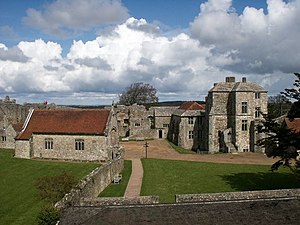Carisbrooke Castle
| Carisbrooke Castle | |
|---|---|
| Carisbrooke, Isle of Wight, England | |

The interior of Carisbrooke Castle
|
|
| Coordinates | 50°41′13″N 1°18′48″W / 50.6869°N 1.3134°WCoordinates: 50°41′13″N 1°18′48″W / 50.6869°N 1.3134°W |
| Grid reference | grid reference SZ486877 |
| Type | Castle |
| Site information | |
| Owner | Managed by English Heritage |
| Open to the public |
Yes |
| Condition | Complete |
| Site history | |
| Built | Begun in 12th century |
| In use | Until 1944 |
| Garrison information | |
| Past commanders |
Sir Nicholas Wadham (died 1542) Captain of the Isle of Wight, 1509-1520 |
| Occupants | Isabella de Fortibus, Charles I of England (imprisoned), Princess Beatrice of the United Kingdom |
Carisbrooke Castle is a historic motte-and-bailey castle located in the village of Carisbrooke (near Newport), Isle of Wight, England. Charles I was imprisoned at the castle in the months prior to his trial.
The site of Carisbrooke Castle may have been occupied in pre-Roman times. A ruined wall suggests that there was a building there in late Roman times. The Anglo-Saxon Chronicle mentions that Wihtgar, cousin of King Cynric of Wessex, died in AD 544, and was buried there. The Jutes may have taken over the fort by the late 7th century. An Anglo-Saxon stronghold occupied the site during the 8th century. Around 1000, a wall was built around the hill as a defence against Viking raids.
From 1100 the castle remained in the possession of Richard de Redvers' family, and over the next two centuries his descendants improved the castle with stone walls, towers and a keep. In 1293, Countess Isabella de Fortibus, the last Redvers resident, sold the castle to Edward I. From then on, its governance was entrusted to wardens as representatives of the crown.
In 1377, in the reign of Richard II the castle was unsuccessfully attacked by the French. It was reputedly saved by local hero Peter de Heyno who shot the French commander. Anthony Woodville, Lord Scales, later Earl Rivers, obtained a grant of the castle and rights of Lordship in 1467. He was responsible for the addition of the Woodville Gate, now known as the Entrance Gate. Woodville was killed by Richard III in 1483, but his brother Edward Woodville was given control of the castle on the accession of Henry VII in 1485.
...
Wikipedia

